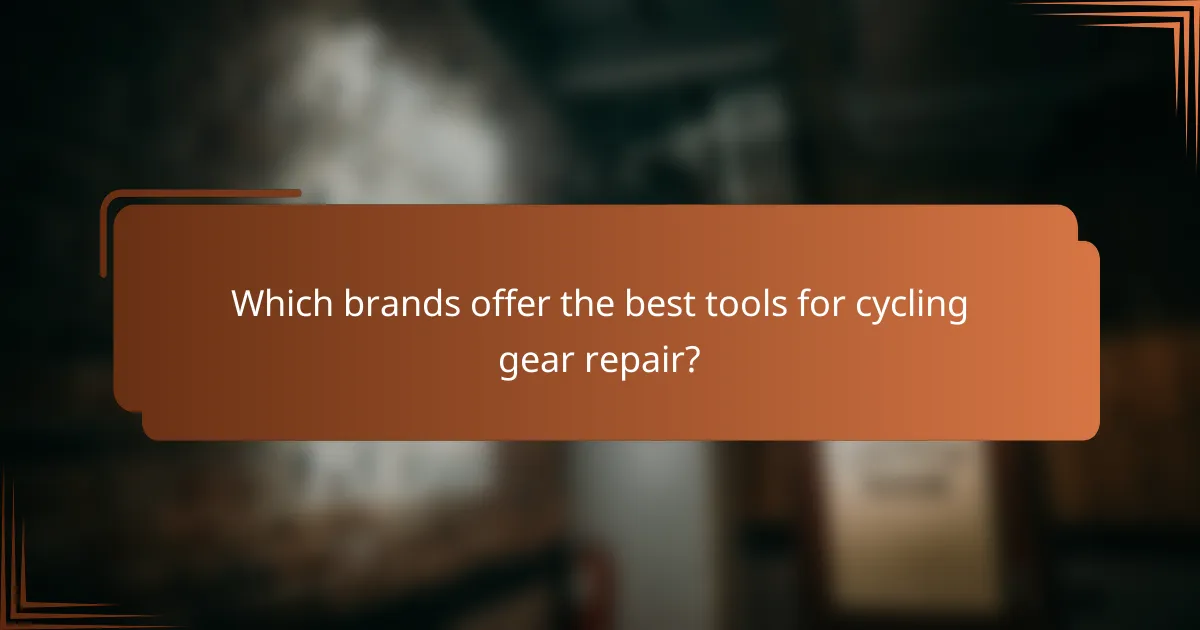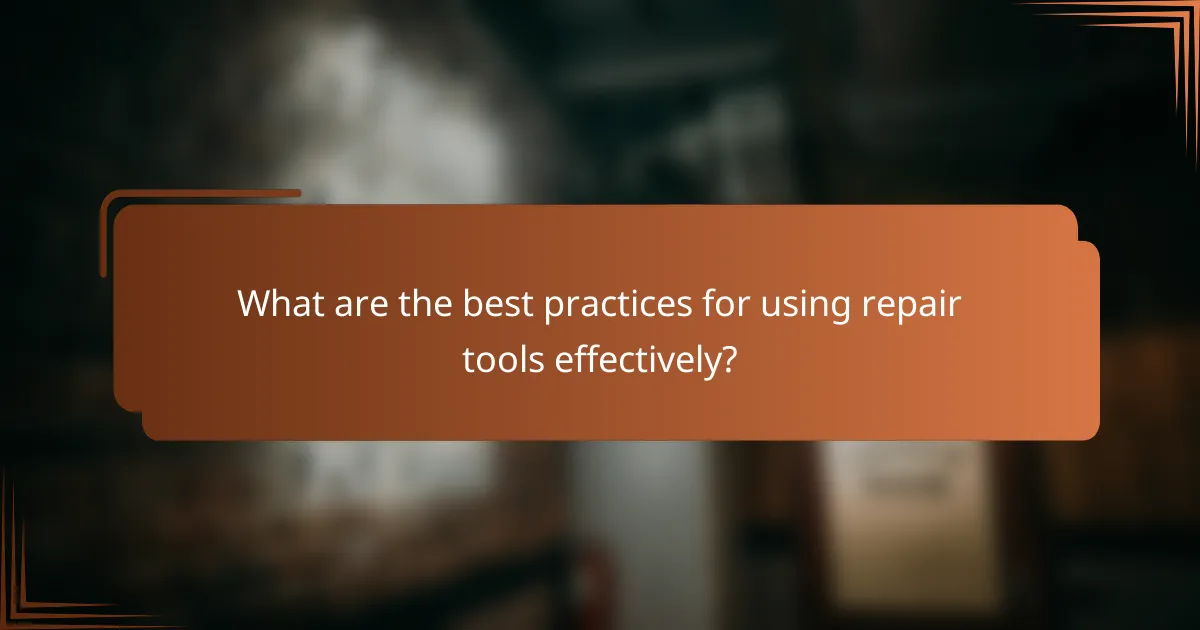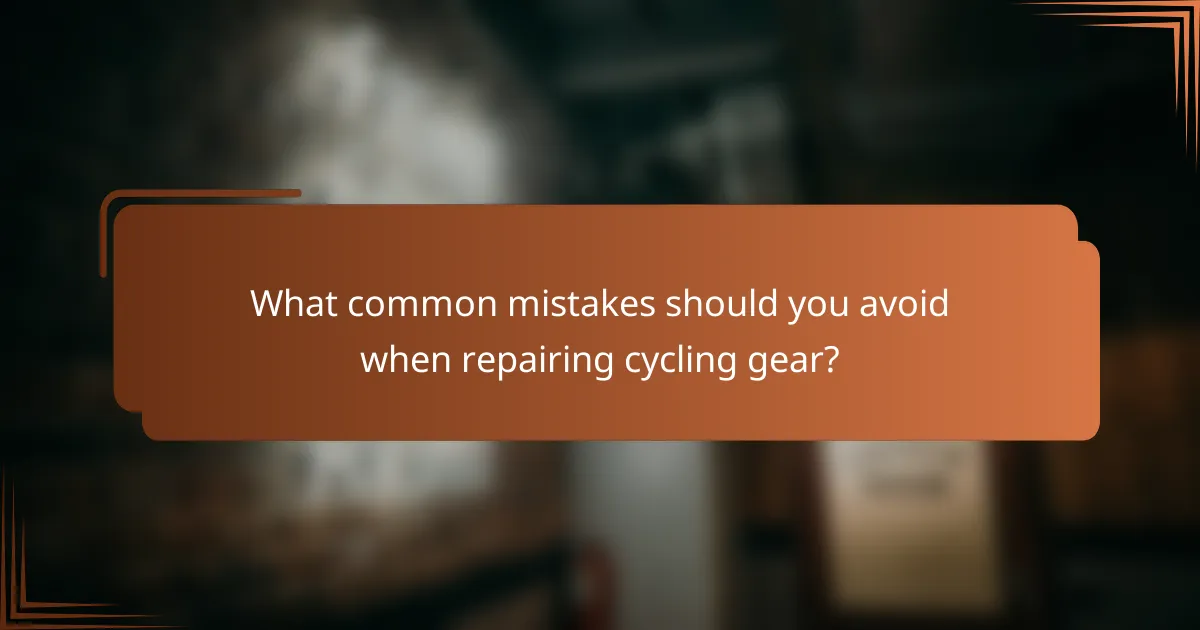Having the right tools for repairing high-performance cycling gear can mean the difference between a smooth ride and frustrating breakdowns. Key tools include a multi-tool, tyre levers, patch kits, chain breakers, and floor pumps. Understanding how to use these tools effectively enhances your ability to address mechanical issues quickly. Additionally, exploring rare tools can further optimise your repair efforts and prolong the life of your cycling gear.

What are the essential tools for repairing high-performance cycling gear?
Essential tools for repairing high-performance cycling gear include a multi-tool, tyre levers, patch kit, chain breaker, and a floor pump. These tools enable cyclists to perform essential repairs efficiently.
A multi-tool typically features various functions, including screwdrivers and wrenches, making it versatile for different repairs. Tyre levers assist in removing and installing tyres without damaging them. A patch kit provides a quick solution for punctured tubes, ensuring minimal downtime. A chain breaker is crucial for fixing or replacing a broken chain, while a floor pump ensures tyres are inflated to the correct pressure for optimal performance.
Having these tools readily available enhances a cyclist’s ability to address mechanical issues on the go, ensuring a smoother and safer ride.
Which tools are indispensable for basic maintenance?
Essential tools for basic maintenance of high-performance cycling gear include a multi-tool, tyre levers, a pump, and a chain breaker. These tools enable cyclists to perform essential repairs and adjustments efficiently.
Multi-tool | Offers various functions in one compact design | Essential for quick adjustments
Tyre levers | Facilitate tyre removal and installation | Prevents damage to rims
Pump | Ensures tyres are properly inflated | Supports optimal performance
Chain breaker | Allows for quick chain repairs | Essential for maintaining drivetrain efficiency
How do specialised tools enhance repair efficiency?
Specialised tools significantly enhance repair efficiency by providing precision, speed, and ease of use. These tools are designed specifically for high-performance cycling gear, allowing for accurate adjustments and quick fixes. For example, torque wrenches ensure the correct tightness of components, preventing damage and ensuring safety. Additionally, multi-tools combine several functions, minimising the need to carry multiple items, which streamlines the repair process. Using the right tools not only saves time but also improves the overall quality of repairs, leading to better cycling performance.
What features should you look for in repair tools?
Look for durability, precision, and versatility in repair tools for high-performance cycling gear. Essential features include ergonomic design for comfort, lightweight materials for portability, and compatibility with various bike components. High-quality tools should offer easy maintenance and reliable performance under various conditions. Consider tools that come with a warranty for added assurance.

How can you identify common issues in high-performance cycling gear?
To identify common issues in high-performance cycling gear, utilise specific tools and techniques. Inspect gear for wear and tear, such as frayed cables or damaged tyres. Use a torque wrench to ensure proper tightening of components, preventing damage from over-tightening. A bike stand allows for thorough inspection and easy access to parts. Regularly check the drivetrain for dirt buildup, which can affect performance. Lastly, keep a multi-tool handy for on-the-spot adjustments.
What are the most frequent problems faced by cyclists?
Cyclists frequently face issues such as flat tyres, brake problems, gear shifting difficulties, chain issues, and frame damage. Addressing these problems requires essential tools for effective repairs.
Flat tyres are common, often caused by punctures or wear. A reliable tyre lever and a portable pump are crucial for quick fixes. Brake problems may arise from worn pads or misalignment; a multi-tool can assist in adjustments. Gear shifting difficulties often stem from cable tension issues, which can be resolved with a simple cable cutter and adjustment tool. Chain issues, like breakage or wear, necessitate a chain tool for replacements. Lastly, frame damage may require a portable repair stand for effective maintenance.
Having these tools on hand allows cyclists to tackle frequent problems efficiently, ensuring a smoother ride.
How do different types of cycling gear affect repair needs?
Different types of cycling gear significantly influence repair needs due to variations in material, design, and usage. High-performance cycling gear, such as carbon fibre frames and advanced electronic components, often requires specialised tools for repairs.
For example, carbon fibre repairs may necessitate epoxy resin and specific sanding tools, while electronic gear may need diagnostic software or specialised wrenches. Additionally, unique attributes of gear, like waterproofing in jackets, can complicate repair processes, requiring careful handling to maintain functionality.
Regular maintenance tools, including tyre levers, patch kits, and multi-tools, remain essential across all gear types. However, high-performance gear may demand additional unique tools or skills, increasing repair complexity and frequency.

Which brands offer the best tools for cycling gear repair?
Brands that offer the best tools for cycling gear repair include Park Tool, Topeak, Lezyne, and Pedro’s. These brands are known for their durable, high-quality tools designed specifically for cyclists.
Park Tool provides a comprehensive range of tools, focusing on professional-grade equipment. Topeak offers innovative multi-tools that combine functionality and portability. Lezyne is recognised for its precision-engineered tools, ensuring reliability. Pedro’s specialises in eco-friendly maintenance products that appeal to environmentally conscious cyclists.
For optimal performance, consider the specific tools each brand offers, such as tyre levers, chain tools, and multi-tools, as they cater to various repair needs.
What makes each brand unique in terms of tool quality?
Each brand of essential tools for repairing high-performance cycling gear is unique due to its specific materials, design innovations, and user-centric features. For instance, Brand A emphasises lightweight construction, while Brand B focuses on ergonomic grips. Brand C offers corrosion-resistant coatings that enhance durability. These variations in tool quality reflect the brands’ commitment to meeting diverse cycling repair needs.
How do regional preferences influence brand popularity?
Regional preferences significantly impact brand popularity by aligning products with local needs and cultural values. Brands that adapt their offerings to regional tastes often see increased loyalty and sales. For instance, high-performance cycling gear may vary in design and features based on climate, terrain, and cycling culture prevalent in different regions. Brands that understand these unique attributes can create targeted marketing strategies that resonate with local cyclists, enhancing their overall appeal.

What are the best practices for using repair tools effectively?
Using repair tools effectively requires proper technique and understanding of each tool’s function. Start by familiarising yourself with essential tools like tyre levers, patch kits, and multi-tools. Always maintain your tools to ensure they perform well. For instance, regularly check the condition of your tyre levers to prevent damage during repairs.
When using a multi-tool, choose the appropriate attachment for the task. This prevents stripping screws and ensures a secure fit. Additionally, practice makes perfect; regularly engage in small repairs to build confidence and skill.
Lastly, consider the workspace. A clean, well-lit area minimises errors and enhances safety. Adopting these best practices will optimise your repair efforts and prolong the life of your cycling gear.
How can you maintain your tools for longevity?
To maintain your tools for longevity, regularly clean, lubricate, and inspect them. Proper storage and handling also contribute to their lifespan.
Start with routine cleaning to remove debris and moisture. Use appropriate lubricants for moving parts to prevent rust and wear. Inspect tools for any signs of damage or wear, addressing issues promptly. Store tools in a dry, organised space to avoid unnecessary damage. Regular maintenance ensures optimal performance and extends the life of high-performance cycling gear tools.
What techniques improve repair outcomes?
Using the right techniques can significantly enhance repair outcomes for high-performance cycling gear. Key techniques include proper cleaning, precise alignment of components, and the use of specialised adhesives for durability.
Effective cleaning removes debris that can hinder repairs and ensures better adhesion. Precise alignment is essential for maintaining gear functionality and performance. Specialised adhesives, such as those designed for high-stress applications, provide lasting strength and flexibility.
Additionally, utilising heat treatment can restore the integrity of certain materials, while regular maintenance checks can prevent future issues. These techniques collectively contribute to improved longevity and performance of cycling gear.

What are the rare tools that can enhance high-performance cycling gear repairs?
Rare tools that enhance high-performance cycling gear repairs include specialised tyre patch kits, precision torque wrenches, chain alignment tools, digital tyre pressure gauges, frame alignment tools, and hydraulic brake bleed kits. These tools address unique challenges in maintaining high-performance gear. For example, a precision torque wrench ensures optimal tightness without damaging components. A digital tyre pressure gauge provides accurate readings for performance optimisation.
Which tools are often overlooked but can be game-changers?
Essential tools often overlooked for repairing high-performance cycling gear include tyre levers, multi-tools, chain breakers, and patch kits. These tools can significantly enhance your repair efficiency and cycling experience.
Tyre levers simplify tyre removal and installation, reducing the risk of damage. Multi-tools provide essential functions like tightening bolts and adjusting components on the go. Chain breakers allow for quick repairs on the chain, ensuring you can continue your ride without lengthy delays. Patch kits are vital for fixing punctures, especially on long rides where spare tubes may not be available.
Using these tools effectively can save time and effort during repairs, making them invaluable for any cyclist.
How do these rare tools compare to standard options?
Rare tools for repairing high-performance cycling gear often outperform standard options in precision and durability. They provide specialised features tailored for specific repairs, enhancing efficiency and effectiveness. For instance, high-end torque wrenches ensure accurate adjustments, while unique tyre levers minimise damage to tyres. Standard tools may lack these specialised attributes, leading to potential issues during repairs. Overall, investing in rare tools can significantly improve the repair process and extend the lifespan of cycling gear.

What common mistakes should you avoid when repairing cycling gear?
Avoiding common mistakes in repairing cycling gear is crucial for optimal performance. Focus on using the right tools, as improper tools can lead to damage. Ensure you have essential items like tyre levers, multi-tools, and patch kits. Skipping routine maintenance can also lead to bigger issues. Additionally, neglecting to follow manufacturer guidelines may void warranties or cause further damage. Always double-check your work to ensure safety and functionality.
How can improper tool use lead to more damage?
Improper tool use can lead to significant damage to high-performance cycling gear. Using the wrong tool or applying excessive force can cause fractures in components, misalignments, or even complete failure. For example, using a standard wrench instead of a torque wrench may strip threads on delicate parts, resulting in costly repairs. Additionally, improper maintenance tools can void warranties, leading to financial loss. Prioritising the right tools ensures optimal performance and longevity of cycling equipment.
What are the signs that a repair is not going as planned?
Signs that a repair is not going as planned include visible damage, unexpected noises, and improper tool usage. If the gear does not function as intended or if parts do not fit correctly, these are clear indicators of issues. Additionally, excessive wear on tools or equipment suggests a lack of compatibility, leading to further complications. Regular assessment during the repair process can help identify these problems early.
What expert tips can help you achieve better repair results?
To achieve better repair results for high-performance cycling gear, use specialised tools, follow proper techniques, and maintain precision. Start with a quality multi-tool designed for bicycles, ensuring you have the right bits for various components. Invest in a reliable tyre lever to facilitate tyre changes without damage. Use a torque wrench to apply the correct tension to bolts, preventing over-tightening. A patch kit is essential for repairing punctures efficiently. Lastly, keep your workspace organised to enhance focus and efficiency during repairs.